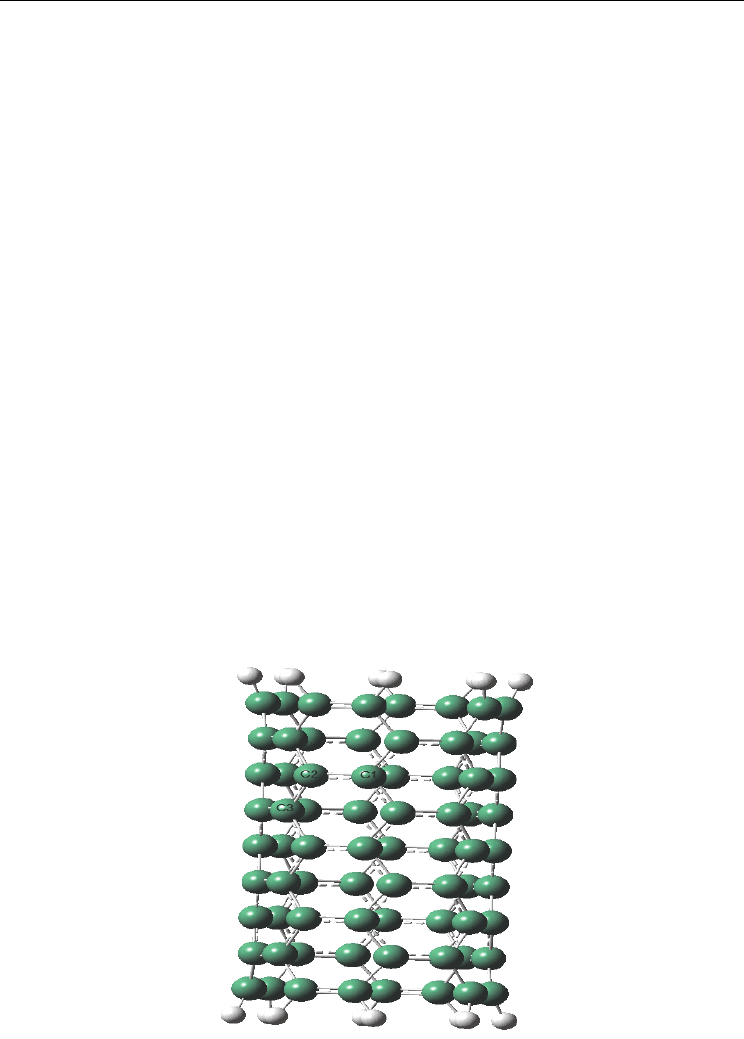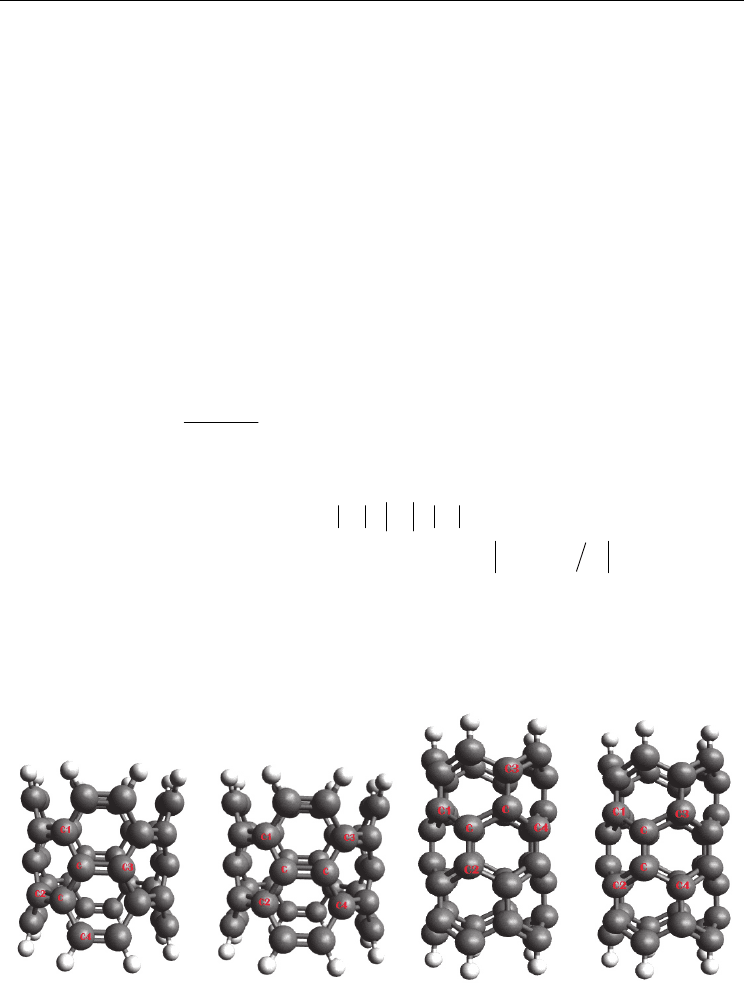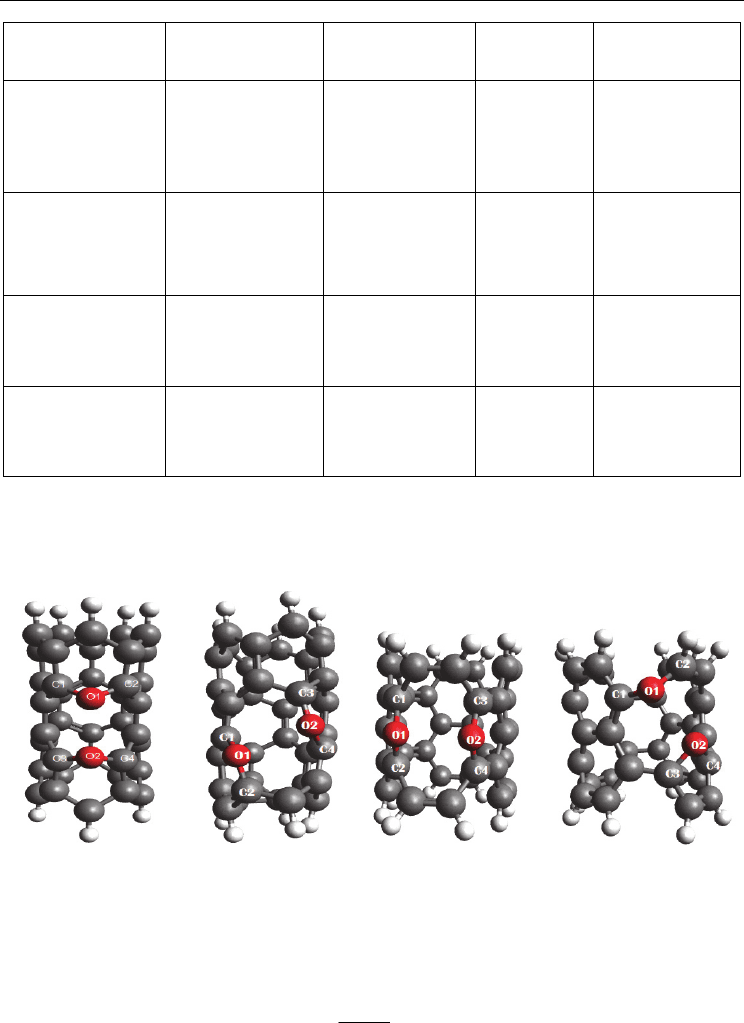Yellampalli S. (ed.) Carbon Nanotubes - Synthesis, Characterization, Applications
Подождите немного. Документ загружается.


Comparison of NQR of O
2
, N
2
and CO on Surface of Single-Walled Carbon Nanotubes and
Chemisorption of Oxygen-Doped on the Surface of Single-Walled Carbon Nanotubes:...
347
can be modified by doping (R.S. Lee, 1997). The conductance of a single oxygen doped (6, 6)
nano-tube decreases by about 30% with respect to that of the perfect nano-tube (N.D. Lang,
2000 & 1998). Ulbricht et al (H. Ulbricht et al., 2002) concluded that no evidence for a more
strongly bound chemisorbed species or for dissociative oxygen adsorption was found. The
effects of oxygen chemisorption on a nano-tube based field effect transistor have been
controversial as to whether it induces oxygen-doping of the nano-tube body or the work
function increase in the semiconductor electrode. The doping effect could be more
influential in devices with longer nano-tubes (S. A. Babanejad et al., 2010; F. Ashrafi et al.,
2010). In this study, two contributions to the resistance of nano-tubes were investigated.
First, we calculate the contact from oxygen chemisorption on a nano-tube with model
semiconductor (5, 0) zigzag and (4, 4) arm chair single-walled carbon nano-tubes (fig 2).
Then we concentrate on the resistance produced by substitutional defects. We show the
chemical-shielding (σ
ii
) tensors were converted to isotropic chemical-shielding (iso) and
anisotropic chemical-shielding (Δσ) and asymmetric (μ
j
) parameters of
17
O and
13
C atoms
for the optimized structures (tables 3 and 4). The study of electronic and structural
properties of oxygen-doped single wall nano-tubes have been performed (M. Mirzaei & N.
L. Hadipour, 2006). The calculation of NMR (M. J. Duer, 2002) parameters using DFT
techniques have become a major and powerful tool in the investigation of molecular
structure. The calculations showed consistent results with the Computational ones. The
tensors originating at the sites (A
1
, A
2
, A
3
and A
4
) of half-spin magnetic nuclei make
available important trends about the electronic properties at the sites of these nuclei. The
tensors were computed in the optimized structures by high-level quantum chemical
calculations (F. Ashrafi et al., 2010; G. Wu, 2002). In this computational evaluation, the
influence of oxygen-doping on the electrostatic properties of zigzag (5, 0) and arm chair (4,
4) CNTs are studied via the tensors calculations at the sites of
17
O nuclei in two case
representative O-doped models (A. S. Ghasemi et al., 2010). The length of 7.1 Å and 4.8 Å
were obtained for (5,0) and (4,4) single-wall nanotube including oxygen-doped (O-doped),
respectively. The forms indicated in figures 2 and 3 are considered in calculations (tables 2
to5).
Fig. 1. CNTs(4,4)

Carbon Nanotubes - Synthesis, Characterization, Applications
348
Dipole
momentum
(Debye)
E
ab
(ev)
R
N-N
(A˚)
R
C-O
(A˚)
R
O-O
(A˚)
R
C-X
(A˚)
(X=O, N, C)
R
C-C
(A˚)
Model
(configuration)
0.4358
- - - -
-
(C-C)
1
=1.424
(C-C)
2
=1.419
(C-C)
3
=1.438
(C-C)
4
=1.405
(C-C)
5
=1.437
(C-C)
6
=1.437
CNT
3.5448
-77910.48
1.250
-
-
-
(C-N)
1
=1.515
(C-N)
2
=1.515
(C-C)
1
=1.48
(C-C)
2
=1.481
(C-C)
3
=1.481
(C-C)
4
=1.481
N
2
-CNTs-A1
1.6172 -77909.73 1.255
-
(C-N)
1
=1.521
(C-N)
2
=1.525
(C-C)
1
=1.504
(C-C)
2
=1.516
(C-C)
3
=1.517
(C-C)
4
=1.500
N
2
-CNTs-A2
3.1747
--79023.84
-
-
-
-
1.485
(C-O)
1
=1.465
(C-O)
2
=1.465
(C-C)
1
=1.487
(C-C)
2
=1.487
(C-C)
3
=1.487
(C-C)
4
=1.487
O
2
-CNTs-A1
3.4475 -79024.74
- -
2.66
(C-O)
1
=1.436
(C-O)
2
=1.408
(C-C)
1
=1.500
(C-C)
2
=1.507
(C-C)
3
=1.563
(C-C)
4
=1.459
O
2
-CNTs-A2
3.4764
-78013.55 - 1.315
-
(C-C)
1
=1.584
(C-O)
2
=1.501
(C-C)
1
=1.481
(C-C)
2
=1.48
(C-C)
3
=1.48
(C-C)
4
=1.48
CO-CNTs-A1
2.6888 -78012.27 1.374
-
(C-C)
1
=1.477
(C-O)
2
=1.562
(C-C)
1
=1.480
(C-C)
1
=1.480
(C-C)
1
=1.461
(C-C)
1
=1.582
CO-CNTs-A2
Table 1. Calculated adsorption energies E
ab
(eV), bond energies(A˚) and dipole momentum
(Debye) of the O
2
and N
2
and CO adsorbed on surface armchair (n, n), n=4 nanotube.
2. Computational details
In this study O
2
and N
2
molecules adsorption behaviors on the end and surface of single-
walled nanotube is taken in to consideration. A (4, 4) CNT containing 72 carbon atoms with
length of 9.8A˚ and a diameter of 5.6 A˚ is selected for this purpose. Saturating carbon

Comparison of NQR of O
2
, N
2
and CO on Surface of Single-Walled Carbon Nanotubes and
Chemisorption of Oxygen-Doped on the Surface of Single-Walled Carbon Nanotubes:...
349
dangling bonds with 16 hydrogen atoms is necessary because there is no periodic boundary
conditions in molecular calculations and also due to limitation of nanotube length and lack
of homogeneity for ending atoms, symmetry breaks down and some changes in geometrical
properties are proved for ending atoms during optimization processes. Optimization of a
sample system includes relaxation of atoms to lower forces from other constituents on each
atom. Calculations were carried out with Gaussian98 suite of programs at all-electron level
(M. J. Frisch et al., 1998). It has been established that DFT is able to accurately treat such
systems due to incorporation of the exchange-correlation effects (V. Barone et al., 2004; W. L.
Yim, & Z. F. Liu, 2004; X. Lu et al., 2005). In quadrupolar spin system, the electric field
gradient (EFG) tensor at nitrogen-14 and oxygen-17 nuclear sites has axial symmetry
(asymmetry parameter
0
). The existence of the zero asymmetry parameter was one of
the reasons why this compound is considered to present such interest (S. A. Babanejad et al.,
2010; F. Ashrafi et al., 2010; E. A. Hill & , J. P. Yesinowski, 1997; A. Abragam, 1961).
Geometry optimizations and EFG calculations were performed using 6-311G* basis set with
B3LYP functional (H. S. Kang, 2006; S. Hou, 2004). The interaction between nuclear electric
quadrupole moment and EFG at quadrupole nucleus is described with Hamiltonian (A.
Abragam, 1961)
22 22
2
[3 ) ( )]
4(2 1)
ZZ
ZXY
Q
е Qq
II II
II
where eQ is the nuclear electric
quadrupole moment, I is the nuclear spin and q
zz
is the largest component of EFG tensor.
The principal components of the EFG tensor, q
ii
, are computed in atomic unit
21 2
(1 au = 9.717365 10 V m )
, with
xx
yy
zz
qqq
and
0
xx yy zz
qqq
. These
diagonal elements are related by a symmetry parameter
Q
yy
xx zz
qqq
and 0 1
Q
,
that measures the deviation of EFG tensor from axial symmetry (E. A. C. Lucken, 1992).
Cluster model is proved to be valid for nanotubes (G. E. Froudakis et al., 2003; D. C. Sorescu
et al., 2001). The computed q
zz
component of EFG tensor is used to obtain nuclear
quadrupole coupling constant from the equation
2
/
QZZ
CeQ
q
h
(E. A. C. Lucken, 1992).
Fig. 2. (A
1
& A
2
) The (5, 0) and (4, 4) SWCNT
CNT(5,0)(A
2
)
CNT(4,4)(A
1
)
CNT(4,4)(A
2
)
CNT(5,0)(A
1
)

Carbon Nanotubes - Synthesis, Characterization, Applications
350
In the present study, the effects of oxygen (O
2
) molecules chemisorption on SWCNTs of
models (4, 4) and (5, 0) was investigated. In order to investigate the electronic structure in
semiconductor nanotube contacts of O
2
molecules, the computations were fully
implemented by Gaussian 98 Software package (E.B. Barros et al., 2007; A.G. Souza Filho et
al., 2006; M. J. Frisch et al., 1998). Geometry optimizations were performed using 6-31G*
basis set with DFT/B3LYP functional (R. G. Parr & W. Yang, 1994; A. D. Becke, 1993). NMR
17
O and
13
C chemical shielding calculations were computed at B3LYP/6-311G* level of
theory using gauge including atomic orbitals (GIAO) approach (K. Wolinski et al., 1990).
The undoped models (4, 4) and(5, 0) consisted of 40 C atom with length of 4.8 Å and 7.1 Å
are chosen for the purpose, respectively. In absence of periodic boundary conditions in
molecular calculations, it is necessary to saturate the carbon dangling bonds with hydrogen
atoms. Curvature of small tubes is a crucial feature responsible for intense interaction of
atoms in tubes. Quantum chemical calculated tensors at the principal axes system (PAS) (σ
11
≤ σ
22
≤ σ
33
) is converted to a diagonal matrix with σ
11
, σ
22
and σ
33
components , measurable
NMR parameters, chemical shielding isotropic (σ
iso
), chemical shielding anisotropic (Δσ) and
asymmetric (μ
j
) are used, respectively (M. J. Duer, 2002). This shows a second-order change
in the molecular energy.
Model r
C-C
r
C-O
R
O-O
ΔE
abs
- DFT
CNT(4,4)(A
1
)
(C-C)
1
=1.421
(C-C)
2
=1.422
(C-C)
3
=1.421
(C-C)
4
=1.422
- - -
CNT(4,4)(A
2
)
(C-C)
1
=1.451
(C-C)
2
=1.419
(C-C)
3
=1.422
(C-C)
4
=1.452
- - -
CNT(4,4)-O
2
(A
3
)
-
(C-O)
1
=1.333
(C-O)
2
=1.334
(C-O)
3
=1.334
(C-O)
4
=1.333
2.563 -43762.03
CNT(4,4)-O
2
(A
4
)
-
(C-O)
1
=1.378
(C-O)
2
=1.395
(C-O)
3
=1.386
(C-O)
4
=1.384
2.547 -43763.24
a
All calculated distances are in Å. All calculated binding energies are in electron volt (eV).
Table 2. Calculated structural parameters and binding energies of O
2
Chemisorption on the
(4 , 4) SWCNT
a
.
000 0
1
N
i
i
EE BB B
(1)
The summation is taken over the O nuclei in the system. We are not interested in the
magnetic susceptibility, χ, but only in the bilinear response property.

Comparison of NQR of O
2
, N
2
and CO on Surface of Single-Walled Carbon Nanotubes and
Chemisorption of Oxygen-Doped on the Surface of Single-Walled Carbon Nanotubes:...
351
Model r
C-C
r
C-O
r
O-O
ΔE
ads
- DFT
CNT(5,0)(A
1
)
(C-C)
1
=1.437
(C-C)
2
=1.451
(C-C)
3
=1.437
(C-C)
4
=1.451
- - -
CNT(5,0)(A
2
)
(C-C)
1
=1.426
(C-C)
2
=1.451
(C-C)
3
=1.408
(C-C)
4
=1.437
- - -
CNT(5,0)-O
2
(A
3
)
-
(C-O)
1
=1.408
(C-O)
2
=1.408
(C-O)
3
=1.408
(C-O)
4
=1.409
2.421 -43652.95
CNT(5,0)-O
2
(A
4
)
-
(C-O)
1
=1.375
(C-O)
2
=1.373
(C-O)
3
=1.335
(C-O)
4
=1.399
2.563 -43653.63
a
All calculated distances are in Å. All calculated binding energies are in electron volt (eV).
Table 3. Calculated structural parameters and Chemisorption energies of O
2
adsorbed on the
(5, 0) SWCNT
a
.
Fig. 3. Chemisorption configurations of an O
2
molecule (The sites A3, A4 of (4, 4) and(5, 0)
SWCNT-O
2
, respectively)
2
0
ij
ij
ij
B
E
B
(2)
CNT(5,0)-O
2
(A
4
)
CNT(5,0)-O
2
(A
3
)
CNT(4,4)-O
2
(A
4
)
CNT(4,4)-O
2
(A
3
)

Carbon Nanotubes - Synthesis, Characterization, Applications
352
Where μ
j
is the components of magnetic moment and B
i
is external magnetic field. The
principal components for specification of shielding are defined by this coordinate system as
following equation (C.M. Marian, & M. Gastreich, 2001).
11 22 33
22 11
33
()
33
(), ,
232
iso iso
(3)
In which σ
iso
, Δσ and are isotropic, anisotropic and asymmetric parts of tensor, respectively
and in certain cases vanishes.
3. Results and discussion
Geometries, binding energies and NQR (4, 4) SWCNT interacted with O
2
,N
2
and CO
molecule species have studied in this work. The calculated geometry parameters and
binding energies, dipole momentum and EFG tensors have shown in tables 1 and 5 in the
following sections, molecular geometries and binding energies, E
ab
, C
Q
, EFG tensors and the
data obtained from O
2
, N
2
, and CO molecules adsorptions are discussed, separately.
In the present work, two models of zigzag (5,0)and armchair (4, 4) SWCNTs with specefied
tube lengths are studied using quantum chemical calculations (figs. 2 and 3). Chemical
shielding tensors of H-capped (5, 0) and (4, 4) SWCNTs interacted with oxygen molecules
are obtained. The calculated geometry parameters and binding energies and
17
O and
13
C
chemical shielding tensors are presented in tables 2 to 5. The molecular geometries and
binding energies and NMR chemical shielding tensors resulted from oxygen molecular
chemisorptions are discussed in following sections, sepa.
3.1 Geometries properties and adsorption and binding energies
In this study, the use of electronic properties of nano tubes has been established to appear
field of spin-electronics, a field that influences the electron’s spin degree of freedom for
transfer and storage of information and communication.
The optimized geometries of
calculated configurations of O
2
, N
2
, and CO molecules adsorbed on (4, 4) SWCNT are
schematically displayed in fig. 4. Geometrical parameters, adsorption energies and dipole
moment are summarized in table1. The nature of stationary points are confirmed by
vibrational frequency calculations at the B3LYP/6-311G* level. For nitrogen, oxygen and CO
molecules we have considered distinct adsorption sites, marked as CNT, CNT–O
2
, CNT–N
2
and CNT–CO adsorption energies,
E
ab
, (Table1) are calculated using:
E
ad
= E
tot
(moleculeO
2
+ CNT
S
) -E
tot
(CNT
S
) - E
tot
(moleculeO
2
) (4)
E
ad
= E
tot
(moleculeN
2
+ CNT
S
) -E
tot
(CNT
S
) - E
tot
(moleculeN
2
) (5)
E
ad
= E
tot
(moleculeCO + CNT
S
) -E
tot
(CNT
S
) - E
tot
(moleculeCO) (6)
Where, E
tot
(CNT), E
tot
(O
2
), E
tot
(CNT+O
2
), E
tot
(N2), E
tot
(CNT+N
2
), E
tot
(CO) and E
tot
(CNT+CO) are the energies of the optimized tubes, which are adsorption systems,
respectively
. By this explanation, E
ad
< 0 corresponds to exothermic adsorption which leads
to local minima stable for adsorption of gas molecules on the surface of nanotube. Armchair
(4, 4) nanotube has two different C–C bonds ((C1–C2) =1.405A˚ and (C2–C3) =1.438A˚) thus
suggests two distinct adsorption sites. A diagrammatic view of this form is showed in fig. 4.

Comparison of NQR of O
2
, N
2
and CO on Surface of Single-Walled Carbon Nanotubes and
Chemisorption of Oxygen-Doped on the Surface of Single-Walled Carbon Nanotubes:...
353
CNT, N2-CNT-A1&2, O2-CNT-A1&2 and CO2-CNT-A1&2. Such a structure has also been
observed for other SWCNTs (S. Dag et al., 2003; H. He et al., 1998; S. P. Walch, 2003). For the
molecular O
2
–CNTs, N
2
-CNTs, and CO–CNTs systems, O2, N2
and CO seemed to place
parallel to the outer surface of the tube. Geometry calculations of distortion caused by the
oxygen and nitrogen and carbon monoxide molecules on the (C1–C2) bond are changed
partly. Placing the oxygen molecule in CNT-A1, CNT-A2
sites doesn’t change the bridge
distance of (C2–C3) considerably. Two different types of adsorbed O
2
, N
2
and CO molecules
were recognized (Fig. 4. CNT, N
2
-CNT-A1, N
2
,- CNT-A2,
O
2
-CNT-A1, O
2
,- CNT-A2, CO-
CNT-A1 and CO-CNT-A2). The calculated adsorption energies were predicted to be -
77910.48 and
-77909.73 eV for N
2
and -79023.84 and -79024.74 eV for O
2
and -78013.55 and -
78012.27 eV for CO, respectively. The length of nanotube have selected with regard to the
length of unit cell of nanotube. Such adsorptions of O
2
molecule are known as cycloaddition
which is very similar to those found for larger diameter tubes (M. J. Duer, 2002; Y. F. Zhang
& Z.F. Liu, (2004). Nitrogen molecules adsorbed with a comparatively lower rate and almost
never formed a chemical binding with the carbon nanotube. The geometry of (4, 4) tube is
considerably modified when such oxidation occurs and physisorbed product is formed. The
electron configuration of O
2
is KK (
2s
)
2
(
2s
*)
2
(
2pz
)
2
(
2px
)
2
(
2py
)
2
(
2px
*)
1
(
2py
*)
1
.
The electron configuration of N
2
is KK (
2s
)
2
(
2s
*)
2
(
2px
)
2
(
2py
)
2
(
2pz
)
2
, and the
transferred electron is placed in the half-filled anti-bonding orbital of O
2
, thus weakens the
O–O bond. The electron can't enter into N
2
molecule binding orbital because the binding
orbital is filled. This arrives to either sp
3
hybridization for two carbon atoms or breaking of
one C–C bond. Two different types of adsorbed O
2
, N
2
, and CO species were identified (Fig.
4. and Table 1). Also, the dipole moments were calculated by Gaussian software and have
shown in table1. Obtained values demonstrate that as the dipole moment becomes bigger,
the absolute value of bond energy increases. We can explain this reality as following: the big
dipole moment relies to the large distance between electron clouds, then, as the distance
becomes bigger the absolute value of bond energy will become higher. By comparing the
obtained results with Jordan's one (D. C. Sorescu et al., 2001). It is well known that the
tendency for sp
2
–sp
3
re hybridization upon O
2
adsorption is strong for thin nanotubes,
because highly bent sp
2
bonding of thin nanotubes is favored for the transition to sp
3
bonding. According to adsorption energy and dipole moment parameters in table1, O
2
molecule shows the highest adsorption rate.
This is a general reason for the binding performed studies, which shows that nitrogen
molecules energy values of adsorption on armchair model with determined diameter and
length have about twice differences in grandeur. Based on performed calculations, we
approach that the adsorption accomplishes over open ends of nanotubes has more
advantages. In addition, all these energies are positive which demonstrate the reaction is
improbable. Based on these results, we can conclude that the physical adsorption over the
surface area of nanotube occurs very hard and so this is an appropriate case.
Also, In this section, stable configurations of oxygen molecule chemisorption at the surface
of SWCNT are discussed. After optimized structures were obtained, geometrical parameters
and binding energies of the models structure of these oxygen molecule attached to the
zigzag (5, 0)and armchair (4, 4) SWCNTs were calculated as shown in Figures (2) and (3).
The results at the level of the B3LYP DFT method and the 6-311G* standard basis set are
summarized in tables 1 and 2. Upon chemisorption of a O
2
molecule on the C-C bond at the
surface, the molecule O
2
dissociates toward the O-O bond lengths. Chemisorption on nano-
tube increases from 1.21 Å and 2.528 Å to 2.563 Å for (4, 4) and (5, 0) SWCNT, respectively.

Carbon Nanotubes - Synthesis, Characterization, Applications
354
We have considered two distinct chemisorption sites, marked as A
1
, A
2
, A
3
and A
4
(table 1
and 2). CNT and CNT–O
2
binding energies, E
ad
, are calculated using, E
ad
= E
tot
(moleculeO
2
+ CNT
S
) -E
tot
(CNT
S
) - E
tot
(molecule O
2
) Where, E
tot
(CNT), E
tot
(O
2
) and E
tot
(CNT+O
2
) are the
energies of the optimized tubes, that are chemisorption and tube–adsorb ate systems,
respectively. Armchair (4, 4) and zigzag (5, 0) tube has different C–C bonds thus offers two
distinct chemisorption sites (table 1and 2) before and after the doping of O atoms, the bond
length of in SWNT-A
1
(4, 4) from.
(C-C)
1
,
3
=1.421 A˚ and (C-C)
2
,
4
=1.422 A˚ decreased to 1.333A˚-1334 A˚ and bond length of in
SWNT-A
2
(4, 4) ) from (C-C)
1
=1.451A˚ , (C-C)
2
=1.419A˚ , (C-C)
3
=1.422A˚ and (C-C)
4
=1.452A˚
decreased to 1.378 -1.395 before and after the doping of O atoms, the bond length of in
SWNT-A
3
(5,0) from (C-C)
1
,
3
=1.437A˚ and (C-C)
2
,
4
=1.451A˚ decreased to 1.335 A˚ - 1.399 A˚
bond length of in SWNT-A
4
(5, 0) ) from (C-C)
1
=1.426 A˚, (C-C)
2
=1.451A˚ , (C-C)
3
=1.408A˚
and (C-C)
4
=1.437A˚ increased to 1.454-1.475 Density functional calculations of SWNT,
efficient process of charge transfer between the oxygen molecule and the nano-tube is found
to substantially reduce the susceptibility of the π-electrons of the nano-tube to modification
by oxygen while maintaining stable doping. Oxygen chemisorption can be achieved with
O
2
+
ion implantation 28668ce95cc(T. Kamimura et al., 2005).
3.2 The N
2
, O
2
and CO NQR parameters and
17
O NMR parameters (4, 4) and (5,0)
Semiconducting SWCNTs are ballistic conductors with two and one spin degenerate
conducting channel(s), respectively (A. Bachtold et al., 2000; V. Krstić et al., 2000). The
channels belong to the first
π and π*-band of the delocalized π-electron system. The N-14, O-
17, C-13 NQR parameters (C
Q
and
) in the geometrically optimized SWCNTs model
armchair (4, 4) were estimated by EFG tensors calculations at the B3LYP level of the DFT
method and the 6-311G* standard basis set.
Tables 6 shows the calculated NQR and EFG tensors for SWCNTs
parameter of O
2
, N
2
and
CO adsorption on the CNTs surface has a remarkable effect on EFG tensors. A glimpse to
values presented in table 2 reveals that the for N-14 and O-17 changes in EFG tensor for
molecular adsorptions are quite significant which is in complete agreement with
calculations. The B3LYP/6-311G* calculations indicate that all three principal components of
the EFG tensor(q
ii
) and associated asymmetry parameter are affected due to adsorption of
oxygen, nitrogen and CO molecules. For the (O
2
–CNT) and (N
2
–CNT) systems, the EFG
tensors of CNT (4, 4)- O
2
(A2) and CNT(4, 4)-N
2
(A1) are more significantly affected
compared to CNT(4, 4)- O
2
(A1) and CNT(4,4)-N
2
(A2), respectively. As previously
mentioned, oxygen molecules adsorption at the CNT (4, 4)-O
2
(A2) leads to the O
1
–O
2
bond
cleavage and N
2
molecules adsorption at the CNT(4, 4)-N
2
(A1) breaks C1-C2 bond.
Therefore, a noticeable change in the field gradient, especially at the C
1
and C2 is detected.
O
2
adsorptions produce more EFG change at CNT (4, 4)- O
2
(A2 which can be attributed to
their hybridization effect (from sp
2
to sp
3
). This is consistent with the bond angle distortion
from 120 to 109, induced by oxygen and nitrogen adsorption. The principle components of
EFG tensor change significantly after CO adsorption at C1 and C2 atoms in CNT(4, 4)-CO
(A2).
New data and presentation of results are given here for O-doping computational NMR
parameters of oxygen nuclei for two models (4,4) and (5, 0) of CNTs (Table 3and 4). Oxygen
molecule chemisorptions of SWCNTs have remarkable influence on NMR tensors, which is
in complete accordance with the facts mentioned above. Consequently, it has been
17
O

Comparison of NQR of O
2
, N
2
and CO on Surface of Single-Walled Carbon Nanotubes and
Chemisorption of Oxygen-Doped on the Surface of Single-Walled Carbon Nanotubes:...
355
indicated that for the H-capped SWCNTs, the calculated
17
O chemical shielding values at
the ends are smaller than in the tube’s center if the carbon is directly bound to hydrogen;
otherwise it is larger (H.J. Liu, 2007). It is also depicted that.
chemical shielding components converge in a way similar to that of the chemical shifts
when increasing the tube length albeit not as smoothly as the isotropic shielding.
Model
17
O atoms
σ
ii
(σ
11
, σ
22
, σ
33
)
b
σ
ισο
Δσ η
σ
CNT(4, 4)
(A
1
)
-
C
1
C
2
C
3
C
4
(-1.16; -1.16; 163.87)
(-1.16; -1.16; 163.87)
(-0. 73; -0. 73; 163.79)
(-0. 75; -0. 75; 163.74)
53.8495
53.8495
54.1090
54.0800
165.0308
165.0308
164.5215
164.4900
0.0000
0.0000
0.0000
0.0000
CNT(4, 4)
(A
2
)
-
C
1
C
2
C
3
C
4
(-0.71; -0.71; 163.77)
(-40.9778; 52.7796;
159.7877)
(-35.3100; 13.8404;
175.9600)
(-1.17; -1.17; 163.85)
54.1157
57.1965
51.4968
53.8354
164.4815
153.8868
186.6948
165.0219
0.0000
2.4588
1.4317
0.0000
CNT(4, 4)-
O
2
(A
3
)
O
1
C
1
C
2
(-66.8441; 54.0846;
83.9711)
(-66.4764; 53.8616;
84.4001)
23.7372
23.9284
90.3508
90.7075
2.0077
1.9900
O
2
C
3
C
4
(-66.7714; 54.0488;
83.9700)
(-66.3669; 54.0373;
84.0975)
23.7491
23.9226
90.3313
90.2623
2.0063
2.0009
CNT(4, 4)-
O
2
(A
4
)
O
1
C
1
C
2
(-53.8794; 39.8243;
95.9593)
(-48.5238; 12.7128;
100.4479)
27.3014
21.5456
102.9869
118.3535
1.3648
0.7761
O
2
C
3
C
4
(-29.8179; 7.3599;
103.6236)
(-66.1822; 56.8643;
97.6708)
27.0552
29.4509
114.8526
102.3298
0.4856
1.8037
a
Calculated σ
ii
, σ
iso
and Δσ values are in ppm
b
In each raw, the first number is for σ
11
, the second number is for σ
22
and the third number is for σ
33
.
Table 4. Calculated
17
O NMR parameters for CNT, O
2
–CNT (4, 4) systems
a

Carbon Nanotubes - Synthesis, Characterization, Applications
356
Model
17
O atoms
σ
ii
(σ
11
, σ
22
, σ
33
)
b
σ
ισο
Δσ η
σ
CNT(5, 0)
(A
1
)
-
C
1
C
2
C
3
C
4
(-118.0860; 12.8629; 163.87)
(-116.9704; 13.8079; 159.2077)
(-118.1198; 12.8584; 159.4017)
(-116.9332; 13.8073; 159.2050)
18.0597
18.6817
18.0467
18.6930
212.0138
210.7890
212.0325
210.7680
10.8763
10.5005
10.8866
10.4911
CNT(5, 0)
(A
2
)
-
C
1
C
2
C
3
C
4
(-45.2746; 155.1751; 325.7105)
(-118.1198; 12.8584; 159.4017)
(-27.4737; 155.3875; 319.5851)
(-0.0454; 120.08; 120.08)
145.2037
18.0467
149.1663
78.5398
270.7602
212.0325
255.6282
62.3103
2.0707
10.8866
1.8388
0.0000
CNT(5, 0)-O
2
(A
3
)
O
1
C
1
C
2
(-63.2476; 63.5826; 90.1893)
(-69.3226; 65.3214 - 8.8003i;
65.3214 + 8.8003i)
30.1748
20.4401
90.0217
67.3219
+13.2005i
6.3048
9.8809 -
0.6458i
O
2
C
3
C
4
(-31.5986; 74.3457; 104.6805)
(-72.6502; 74.9677 -19.9352i;
74.9677 +19.9352i)
49.1425
25.7617
83.3070
73.8090
+29.9028i
3.2338
8.5952 -
1.1607i
CNT(5, 0)-O
2
(A
4
)
O
1
C
1
C
2
(-48.8614; 22.4174; 75.9510)
(-72.6368; 16.2112; 92.0007)
16.5023
11.8584
89.1730
120.2134
1.1990
1.1086
O
2
C
3
C
4
(-48.4295; 2.6526; 96.4404)
(-128.7315; 13.2045; 82.9991)
16.8878
-10.8427
119.3289
140.7627
0.6421
1.5125
a
Calculated σ
ii
, σ
iso
and Δσ values are in ppm
b
In each raw, the first number is for σ
11
, the second number is for σ
22
and the third number is for σ
33
.
Table 5. Calculated
17
O NMR parameters for CNT, O
2
–CNT (5, 0) systems
a
.
